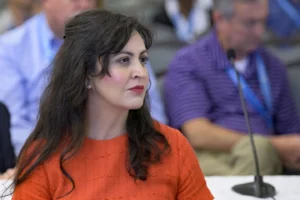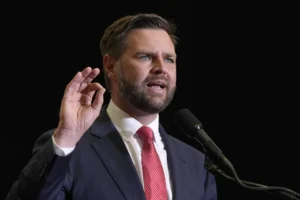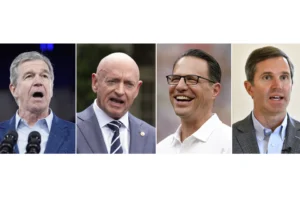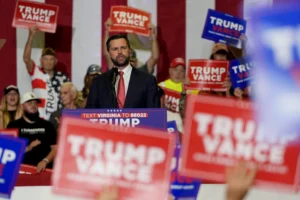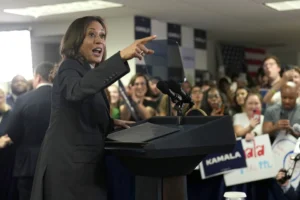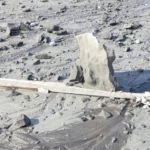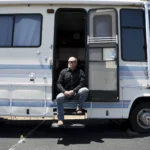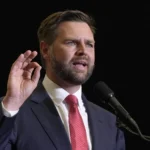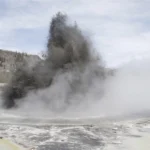Cheney: Trump’s Response to Mob of Armed Supporters ‘Indefensible’
The Wyoming Republican’s participation on the panel imperils her reelection chances
- Published In: Politics
- Last Updated: Jul 22, 2022
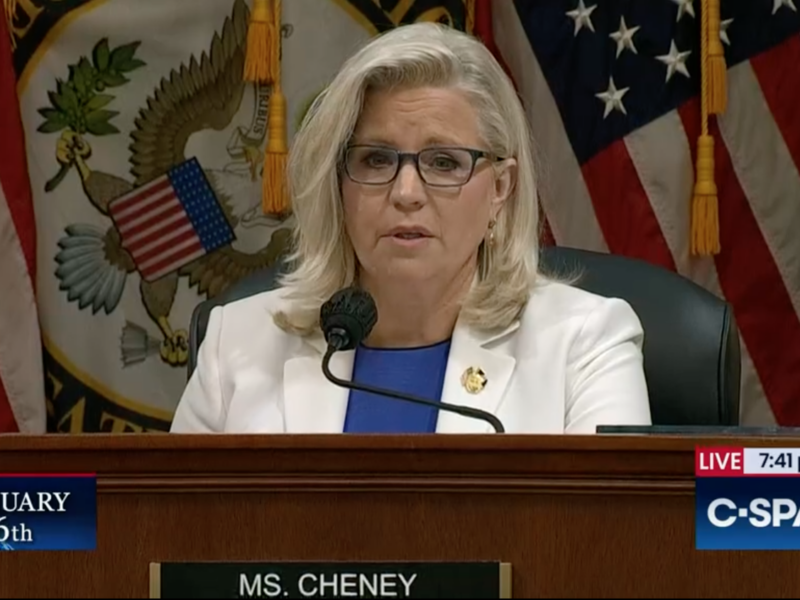
With chairman Rep. Bennie Thompson (D-Miss.) absent due to a positive Covid-19 diagnosis, vice-chair Rep. Liz Cheney (R-Wyo.) leads the final public hearing of the Jan. 6 committee's summer series. (Courtesy photo from C-SPAN)
By Jacob Gardenswartz
Special to the Wyoming Truth
WASHINGTON — During Thursday’s primetime hearing of the House select committee investigating the Jan. 6 insurrection, the panel’s ninth and final public presentation until the fall, lawmakers scrutinized every second of former President Donald Trump’s response to the violence at the U.S. Capitol — or lack thereof.
Through never-before-seen videos and testimony, committee members detailed what transpired during the 187 minutes between the conclusion of Trump’s remarks to his supporters outside the White House and his release of a late-afternoon video instructing rioters to leave the Capitol grounds. Over those three-plus hours, according to testimony, Trump did little more than watch the violence unfold on television, phone Congressional allies to urge them to halt the certification of President Joe Biden’s victory and tweet attacks at his own vice president.
“On January 6, when lives and democracy hung in the balance, President Trump refused to act because of his selfish desire to stay in power,” said Rep. Elaine Luria (D-Va.), a former Naval officer and committee member.

In addition to videos from dozens of pre-taped depositions, lawmakers heard from two senior members of Trump’s White House, each of whom resigned in protest after the violence on Jan. 6: former deputy White House press secretary Sarah Matthews and former deputy national security advisor Steven Pottinger, who testified that the insurrection “emboldened our enemies.”
Juxtaposed with their testimony about what was happening in the West Wing were contemporaneous accounts of the panic that was unfolding at the Capitol, where an armed mob of Trump’s supporters forced their way into the seat of the legislative branch, bludgeoned police and threatened government officials with violence.
By the time Trump had finished his remarks the morning of Jan. 6, protests outside Congress had already begun to turn violent, lawmakers said, and Trump was immediately informed of what was going on. With the situation quickly deteriorating, Trump fielded numerous pleas to order his supporters to stand down from virtually everyone in his orbit, including top White House lawyers, senior administration officials, Fox News personalities, lawmakers sheltering in secure rooms at the Capitol and several of his own family members.
As Fox News aired videos of his supporters chanting “hang Mike Pence,” Trump did not call them off. Instead, he tweeted his own attack on Pence, writing that the vice president “didn’t have the courage to do what should have been done” and overturn the election.
Matthews testified that she interpreted that statement as “essentially [Trump] giving the green light” to the rioters. “In that moment, for him to tweet out the message about Mike Pence, it was him pouring gasoline on the fire,” she said.
Meanwhile, national security officials at the White House were listening in to the radio communications of Pence’s Secret Service security detail, who were holed up with Pence in the Capitol mere feet from the rioters. One official testified that he heard agents fearful for their lives, some making calls to family members to say goodbye.
That official, whose name was withheld by the committee for fear of possible retribution, also testified he overheard a conversation among top White House lawyers fielding calls from the Pentagon to coordinate a response to the attack. Throughout the entirety of the violence on Jan. 6, Trump did not call the Department of Defense, National Guard, FBI, Attorney General or any other law enforcement body, lawmakers said.
When Trump publicly called on his supporters to go home, lawmakers argued he did so because law enforcement officials had begun to claw back control of the building. Only when “the writing was on the wall” that the rioters wouldn’t succeed in halting the certification of the election did Trump call them off, Luria said.
In that 4:17 p.m. video, Trump told his supporters to “go home in peace.” Trump’s closing statement to protestors that “we love you, you’re very special” helped encourage further staff resignations in the West Wing, witnesses testified.
Back at the Capitol, videos showed how the rioters reacted to Trump’s statement. “I’m here delivering the president’s message: Donald Trump has asked everybody to go home,” Jacob Chansley, sentenced to three-and-a-half years for his involvement in the riots, told the crowd via megaphone. Stephen Ayres, who pleaded guilty to charges related to Jan. 6, said the video “seemed like it started to disperse some of the crowd.”
Among the biggest revelations of Thursday’s hearing concerned the video statement Trump released the following evening, on Jan. 7, more than 24 hours after the last time he’d addressed the nation. Raw, unedited footage of those remarks obtained by the committee showed Trump standing in front of a White House podium looking gloomy as he delivered his first formal condemnation of the insurrection, labeling it a “heinous attack.”
The new video also showed Trump arguing with top aides — including his daughter Ivanka — over the words he would be broadcasting; he took issue with any language conceding defeat. At one moment, Trump stopped himself mid-sentence: “I don’t want to say the election is over,” he bristled.
Absent from Thursday’s hearing was committee chairman Rep. Bennie Thompson (D-Miss.), who recently received a positive Covid-19 diagnosis and could only submit remote video statements. In his place leading the hearing was vice chair Rep. Liz Cheney (R-Wyo.), one of just two Republicans serving on the committee.
The situation thrust Cheney into her most prominent role yet on the committee and came less than a month before Wyoming’s competitive Aug. 16 primary. Cheney’s GOP challengers, including Trump-backed environmental attorney Harriet Hageman, have repeatedly criticized her participation on the panel, which Cheney appeared to rebut in her closing remarks.
“The case against Donald Trump in these hearings is not made by witnesses who are his political enemies,” Cheney said. “It is instead a series of confessions by Donald Trump’s own appointees, his own friends, his own campaign officials, people who worked for him for years, and his own family. They have come forward and they have told the American people the truth.”
Cheney added, “Donald Trump made a purposeful choice to violate his oath of office, to ignore the ongoing violence against law enforcement, to threaten our constitutional order. There is no way to excuse that behavior, it was indefensible.”

